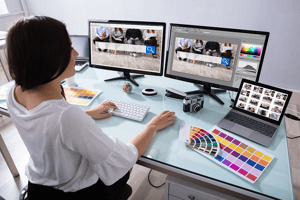Multi-monitor and high-resolution desktops
Workers who process information from one source into another, such as graphics designers, programmers, video editors, digital media workers, are likely to enjoy up to 35% more productivity from running multiple-monitor configurations.
Replacing aged PCs will improve productivity through better reliability and portability, but for a significant boost in productivity consider a multi-monitor configuration. Productivity gains for workers who can benefit from multiple displays are those who tend to process information from one source into another, such as graphics designers, programmers, video editors, digital media workers.
For those doing work where concentration on a single task is most critical, instead look for a single, larger, high-resolution monitor.
Can I use multiple and high resolution displays/monitors?
PCs from the last few years are perfectly capable of running at least two Full HD displays (1920 by 1080 pixels). Having two displays gives a user the ability to place data side-to-side to compare, summarise and transfer data from one source to another. Using single monitor desktops, this sort of transposing requires memory or a split-screen window configuration.
Here at Diamond IT we have most users using two to four displays, with the third and fourth usually used for communications options, such as email and instant messaging.
I personally utilise my Surface Pro 3 display for email, with my two external monitors as a primary workspace and a secondary workspace. This gives me a total of three displays.
How many displays you can support depends on the graphics capability of your PC, and the monitors and monitor ports available on your PC. It's unlikely that a typical PC can support both advantages - i.e. multiple monitors that are also high-resolution.
Workers who need to avoid the distractions of an active and diverse desktop would include writers, artists etc. For these users the high-resolution option of a single monitor of QHD (2560 wide by 1440 high) or UHD (3840 wide by 2160 high) resolution will be ideal. These monitors provide a lot of work space, but to get to a comfortable pixel density you'll want to look at a monitor between 27 and 32 inch for QHD resolution, and 32+ inches for UHD (similar to 4K) resolution.
Graphics Capability
For most modern desktop or portable PCs, the graphics rendering is carried out by the PC's CPU. My Intel i5 4300U includes the Intel HD Graphics 4400, and has no problem running two displays at Full HD and a third at a larger resolution (2160 wide by 1440 high).
The Intel HD 620 graphics in the current Surface Pro (Intel i5 7300U) is capable of much more output.
Computers running a dedicated graphics card are capable of running the best of both worlds - multiple high-resolution monitors.
Output and Input ports
HP notebooks and desktops typically have multiple full-size DisplayPort outputs, while more compact PCs like the Microsoft Surface lines run the smaller mini DisplayPort output ports.
If your monitor doesn't have a matching port, you'll need some type of an adapter and/or cable between the different monitor input ports (VGA, DVI, HDMI, DisplayPort and mini DisplayPort). Most PCs only come with two ports for running external monitors, so you'll need to buy a USB hub or a similar expansion option to add further displays.
Most portable PCs come with an option to expand the number of displays, including the Surface Hub and a range of the new technology Thunderbolt 3 over USB-C hubs.
Eye-strain and health considerations
Don't ignore the benefits to be gained by choosing a monitor of the right size, resolution and clarity!
See my previous blog for more details - 7 tips for better eye health in the work place.
References
The benefits of multiple monitors - a 35% productivity increase!
Will I be able to do more work with three screens?
How can Diamond help?
If you're interested in embracing a multi-monitor desktop standard in your workplace, contact your Business Technology Manager here at Diamond and along with the Presales department we can help you build an effective solution for getting the best productivity out of your PC fleet.
Diamond's Business Technology Managers are available to help you get the most from your PC fleet.
Give us a call on 1300 307 907 or contact us via the form below.





